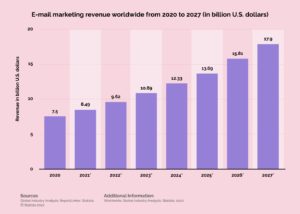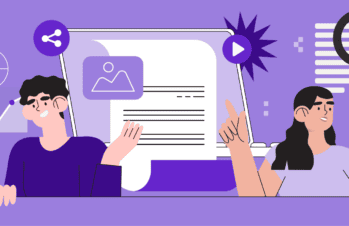Email is still one of the most effective ways to communicate with your customers, and this isn’t going to change in 2023. There are 4 billion daily email users—expected to grow to 4.6 billion by 2025—and a survey of active email users showed that 59% of consumers’ purchase decisions were influenced by marketing emails. Additionally, more than half reported purchasing from marketing emails at least once a month.
For marketers, email is a critical way to build relationships with clients and prospects. And with many businesses operating in remote or hybrid environments, email is even more important. If your business operates strictly online, you must be wary that social media platforms can disappear or change their algorithms at any time, rendering your connection with your audience mute. Email, on the other hand, is an owned channel. When a platform goes down or loses popularity, email is a tried and true way to reach and engage with your audience.
B2B email marketing trends in 2023 will continue along the same path that 2022 email marketing did. With industry revenue estimated to reach almost $11 billion by the end of this year, emails will continue to become more automated, include more videos, be more personalized, and more interactive.

Source: https://www.emailmonday.com/email-marketing-future
Continuing with some of the trends established in 2022, email trends for 2023 fall into eight broad categories.
- Automation
- Personalization
- User-generated content
- Mobile-friendly mindset
- Video
- Interactivity
- Data and privacy
- Content
8 B2B Email Marketing Trends to Know for 2023
Automation
Small businesses, in particular, will need to take advantage of automation if they want to stay competitive. The key behind automation is that it’s designed to save businesses time and money. It’s also linked to consumer behavior, such as filling out a form or adding something to their cart on your website. This means that an automated email is 70.5% more likely to be opened. It provides information to your customers exactly when they need it.
Personalization
Mass impersonal email blasts just don’t work. Emails that use people’s first names get higher open rates than those that simply say “Dear Customer.” It’s also a good idea to personalize the “from” portion of your email. It’s important to make sure it’s clear who the email is coming from. Emails sent from a personalized account are more likely to be opened than those that are sent from a “no reply” address.
But personalization shouldn’t stop at first names and sign-offs. Every aspect of the emails you send should feel personalized to the recipient. Create thoughtful and personalized email subject lines that are relevant to your subscribers. It’s important that the subject line gives your readers an idea of what your email will be about and isn’t just something catchy to try and trick them into opening your email. Nobody likes to be tricked.
Make sure your mailing list is segmented, so the copy can be specific to each segment’s needs rather than general copy that feels impersonal.
User-Generated Content
We talked a lot about user-generated content (UGC) on the Zen blog throughout 2022. It’s hugely popular because people want the opinions of their trusted peers. In fact, 93% of consumers turn to customer reviews and recommendations before making their purchase decisions.
Incorporating UGC in your brand’s email campaigns will heighten the authentic connection recipients will feel towards your brand. Your audience trusts their peers—customer reviews, photos, and video testimonials will carry more weight than cookie-cutter marketing messages.
Mobile-Friendly Mindset
This seems like a no-brainer in 2023. I mean, everyone is on mobile, right? But still, many brands lag in creating emails that can be easily read on a mobile device. Things like subject-line character counts and how images display can make or break a consumer’s interaction with your brand. When thinking about mobile viewing, keep your subject lines short, your content concise, and use clear calls to action and engaging preheader text.
Video
Video requires little effort to understand and is quickly and easily consumed, especially on mobile devices. Until recently, many email management systems (EMS) were unable to display embedded video, but this is quickly changing. If your EMS doesn’t allow embedded video, watch for this to change very soon. In the meantime, animated GIFs can be used in place of video, or you can even use an image with a play button as a way to link to a site where your customers can play your video. Nowadays, it’s pretty cost-effective to hire a freelance animator to create a short set of branded animated gifs for your business, which will inevitably provide a solid ROI.
Interactivity
Interactivity will increase in 2023. Increase engagement by including GIFs, quizzes, countdown timers, and add-to-cart functionality in your emails.
Another way to increase interactivity and engagement is to send to lists that actually want to hear from you. Stop sending to lists with low open rates. Low open and engagement rates hurt your domain reputation and your chances of engaging with other customers who are interested in hearing from you. Don’t be afraid to remove subscribers who aren’t opening your emails.
Have a goal for your email before you hit send. Think about what you want your subscribers to do, if anything, before drafting your email. Identify the purpose of your email, then write the entire email with that in mind. Make it easy for your subscribers to do what you want them to do. If you want them to read your blog post, then provide a link to the post. Provide more than one way for your subscribers to achieve your goal by using links in the text of your email and buttons or calls to action at the end of your email.
Data
Use the built-in analytics that comes with your email management system to improve your open rates. Think of the analytics as feedback and make note of how the numbers move (up or down) when you change something. This often requires a lot of testing.
Play around with the day you send your emails and see what works best for your subscribers. Tuesdays, Wednesdays, and Thursdays are the most popular days to send emails, so an email sent on one of those days is not as likely to be opened because your subscribers will be inundated with emails from other lists they’ve joined.
Make sure you are focusing your data analysis on subscribers who have submitted a form on your website. Don’t buy email lists—or, if you do, make sure to cull that list based on recipient behaviors. If unsubscribing seems to be a trend, then you’ll want to find out what’s going on. This is also true if people aren’t opening your emails. Respect your subscribers’ wishes. If you are marked as spam, then immediately stop sending emails and see if you can find out what may have caused your subscribers to think of your emails as spammy.
The definition of spam has changed. It’s no longer just emails to people who haven’t given you permission to email them—it’s also email that gets sent to subscribers who never open your emails. This is called graymail. Unsubscribes can actually be a good thing because it reduces your chances of sending graymail and increases the chances that your subscribers are actually reading your emails.
Respecting your subscribers’ privacy is also paramount this year. With the trend towards our cookieless future, brands need to be mindful of how much information they collect from their subscribers, how they store that information, as well as the updated laws and regulations regarding digital consumer privacy.
Content
As always, content is king. (We’ll, we may be a little biased, but the stats don’t lie.) Creating high-quality content that adds value for your reader reduces the amount of graymail you send and increases the likelihood of creating an authentic connection with your target audience—someone who will actually convert.
Think about your ideal customer and what they want to know. Do they want tips and tricks, personal stories, or the latest deals? Maybe they want all of those things. Knowing and understanding your customers is key. A good rule of thumb is to send emails that provide value to your customers 80% of the time and promotional emails the other 20%.
If you take these trends into consideration (and avoid these common pitfalls) when building your email marketing strategy for 2023, you’re sure to find success. And if you’d like help making your emails stand out from the crowd, contact our team of experts at Zen Media today.





